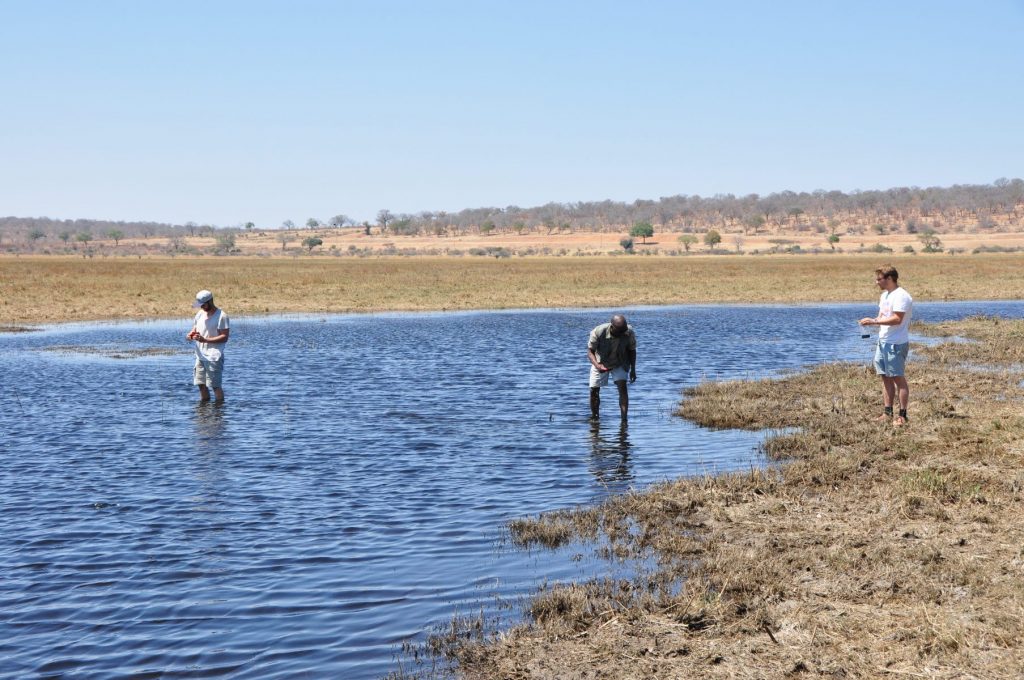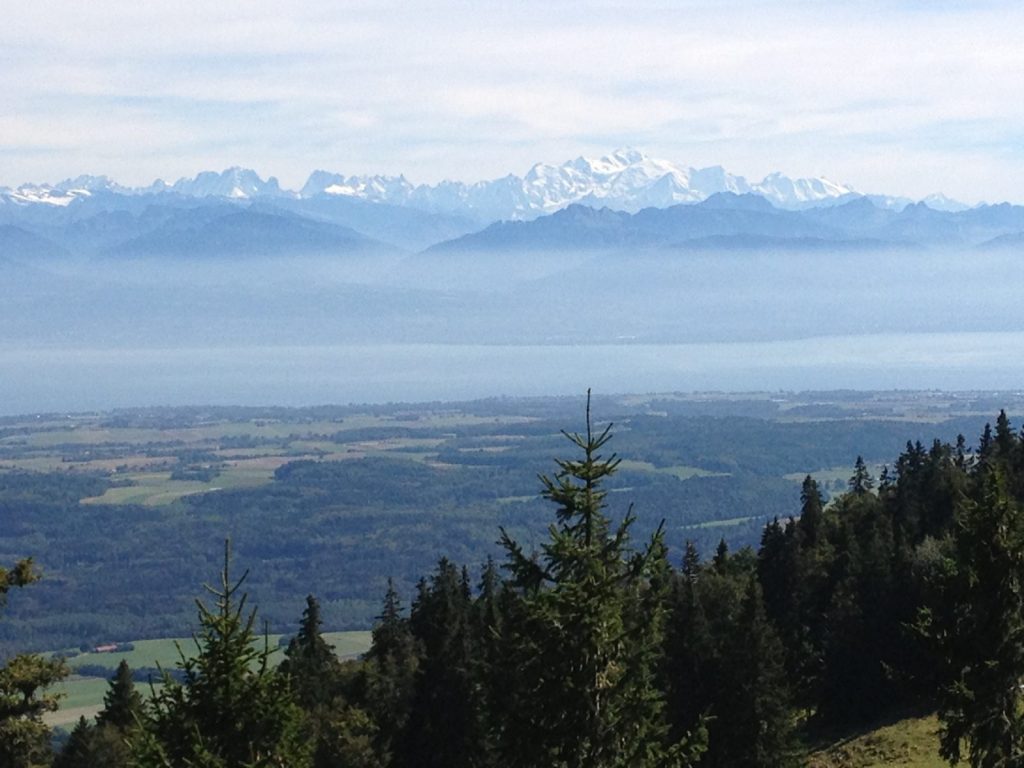• Water resources in the Lake Geneva catchment, canton Vaud, and Switzerland
• Ecosystem studies in Switzerland, Europe but also beyond (such as in the region of Chilika Lake, India)
• Groundwater and natural resource projects on soils and vegetation in Namibia and Botswana
• Clay minerals and tree-rings as archives of hydrologic and climatic changes
• Biomineralization of phosphates and carbonates as climatic as well as paleoclimatic archives
• Fluid-mineral interaction and implications for (Alpine) metamorphism, magmatism, and ore mineralization…
Current Research Group:
Prof. Torsten Vennemann (Torsten.Vennemann@unil.ch)
PD Dr. Jorge Spangenberg (Jorge.Spangenberg@unil.ch)
Dr. Laszlo Kocsis (Laszlo.Kocsis@unil.ch)
Dr. Benita Putlitz (Benita.Putlitz@unil.ch)
and many other colleagues and collaborators…
PhD Students:
Franziska Blattmann (franziska.blattmann@unil.ch)
Gabriel Cotte (gabriel.cotte@protonmail.com)
Oluwaseun Edward (oluwaseun.edward@unil.ch)
Anaël Lehmann (anael.lehmann@unil.ch)
Zoneibe Luz (zoneibeaugusto.silvaluz@unil.ch)
Javier Del Hoyo (javier.delhoyo@unil.ch)
Nazimul Islam (nazimul.islam@unil.ch)
Anthony Michelon (anthony.michelon@unil.ch)
A. Paleoecological indicators in lake sediments based on a multidisciplinary approach of endospore-forming Firmicutes and the chemical and isotopic composition of sediments and organic matter (SINERGIA project CR23I2_162810)

The present work aims at evaluating the utility of the natural abundance of stable carbon and nitrogen isotopes in soils and sediments from lacustrine or swamp environments to trace shifts between C3 and C4 dominance as an estimate of local moisture conditions. Such data could give new insights on the Quaternary and Recent ecological evolution of the region. It focuses on the soil-vegetation interactions, in terms of resource acquisition by plants, and the cycles of carbon and nitrogen, given the particular hydrology of the Okavango-Kwando-Chobe terminal endoreic system. In particular, we aim to improve our understanding the environmental controls on the distribution and productivity of C3 and C4 biomass in the modern environment and subsequently allow for a better reconstruction of the past environment using the carbon isotope composition of paleosols, phytoliths, soil carbonate, and fossil organic matter.
PhD of Anaël Lehmann and Christophe Paul
B. Mixing of Rhône River water in Lake Geneva (Léman): Implications on the biogeochemistry of the lake (IDYST research project)

Lake Geneva as the largest fresh water reservoir of Western Europe, is located at the border between France and Switzerland. More than a million people are living in its watershed and the lake is a major source of drinking water for almost 900’000 inhabitants. It is hosting a wide diversity of plants and animals and it is sustaining the activity of about 140 professional fishermen in both countries. It is important for the tourism and recreation sectors. However, Lake Geneva has suffered from eutrophication since the 1950’s and has experienced a regime shift with consequential modifications of its ecological processes and that also make it more vulnerable to climate change. Moreover, Lake Geneva is suffering from an intense artificialization of its shoreline and from the appearance of emergent pollutions, such as micropollutants and new invasive species (e.g., the quagga mussel). This all poses challenges to the lake management.The PhD of Gabriel Cotte focused on the dispersion of the lake’s main tributary, the Rhône River, in the Lac Léman basin and the impact of its interflow on the biogeochemistry of the lake in the context of the re-oligotrophication. Determining the path of river intrusions into lakes is essential, both for a better understanding of the lake circulation as well as the nutrient transport and the distribution of pollutants introduced by the rivers. Lake Geneva has been on the way of re-oligotrophication since measures have been implemented to control the cultural eutrophication experienced during the second half of the 20th century. Despite a successful control of the nutrient fluxes with time, phosphorus becoming the limiting factor controlling primary production, the phytoplankton biomass increased in the lake. Today, with the additional effect of climate change, the euphotic zone becomes depleted in nutrients earlier during the year. The Rhône River, as the main tributary of Lake Geneva, has also been identified as the major source of nutrients, including phosphate, to the lake. The objective of this thesis is hence to determine the Rhône River water dispersion and its impact on the nutrient dynamics and primary production of the lake. Given the previous success of the unique stable isotope composition of the Rhône River as a conservative tracer of the influx of its waters, these measurements have been used to assess the dispersion of the Rhône River water and hence, comparing such measurements with the nutrient dispersion dynamics, relate this to the general biogeochemistry of the lake.
C. Quantifying decamillennial changes in carbon cycling, climatic and biotic responses to Late Permian-Early Triassic volcanism (SINERGIA project CRSII5_180253)

How large-scale volcanism cascades into greenhouse-icehouse cycles and impacts sea level, species richness of marine organisms as well as terrestrial biologic systems and hence the entire global carbon cycle is the core question of this multidisciplinary project. Integration of a series of environmental parameters into an atmosphere-ocean coupled General Circulation Model (GCM) will provide a crucial test for the respective role of each abiotic parameter and its impact and feedback on other parameters of the model (collaboration with Hugo Bucher, Elke Schneebeli of the University of Zürich and Urs Schaltegger, Christian Verard, Maura Brunetti, and Jérôme Kasparian of the University of Geneva). In a first step, we expect to reach a better understanding of the relations between climate, sea level, and the carbon budget by studying responses and feedbacks triggered by an overriding driver, e.g., massive volcanism. The selected time window has the following assets: (i) a simple Pangea paleogeography and a global sea level low stand; (ii) massive volcanism of the Siberian Large Igneous Province as a driver for global changes; (iii): the largest mass extinction of the Phanerozoic and subsequent recovery-extinction cycles during the following 5 Ma; (iv): a time frame from U-Pb zircon high-precision geochronology that can be compared to an accurate and reliable marine biochronological frame; (v) a newly established global timing of atmospheric changes deleterious to terrestrial plants. The GCM will be coupled to a carbon box model to understand at what rate the largest known Phanerozoic carbon isotope excursions (CIE) were generated and thus to quantify the role of sea level changes and the importance of the continental shelves on the global C cycle. A new highly resolved global paleogeographic model is central for the GCM sensitivity experiments. Important initial and boundary abiotic conditions will be derived from geochemical proxies such as the C-isotope compositions of carbonate and organic matter, O-isotope compositions of biogenic carbonate and phosphate, S-, Sr- and Nd-isotope compositions of fossils and whole rocks, as well as Hg concentrations. These provide the necessary boundary conditions to test and validate the GCM sensitivity experiments. The temporal calibration of all environmental change is achieved through high-precision U-Pb dating of volcanic ash beds. In a second step, the validated results of the GCM simulations will be further injected into an upgraded version of the geophyletic model (a multi-layered cellular automaton) in order to investigate the puzzling differences in the evolutionary responses of nekton and benthos. The repeated decimation of the nekton and the profound alteration of the ecology of terrestrial plants are evidently both in pace with global abiotic stresses, contrasting with the apparent absence of coeval evolutionary responses of the slowly recovering Early Triassic benthos. With the help of a new version of the geophyletic model that will incorporate detailed regional bathymetry as an additional layer for habitat differentiation and that will address both global and regional scales, quantitative assessments of how, and at what background evolutionary rates, can habitat heterogeneity buffer marine organisms against extinction when threatened by global abiotic stressors. This will bring a new and broader perspective to important issues in conservation biology.
PhD’s of Franziska Blattmann, Oluwaseun Edward and Zoneibe Luz, amongst others…
